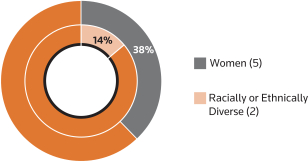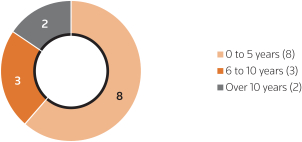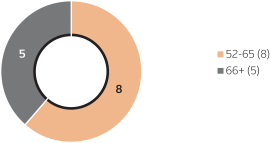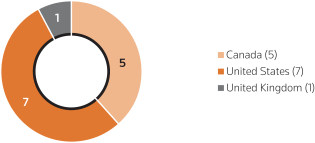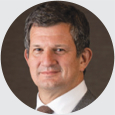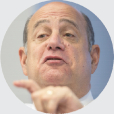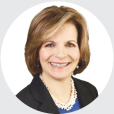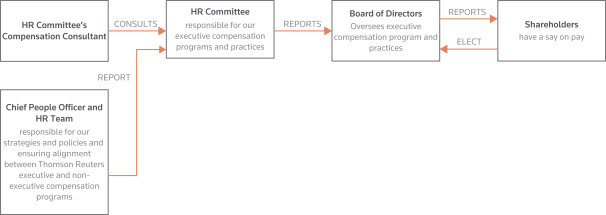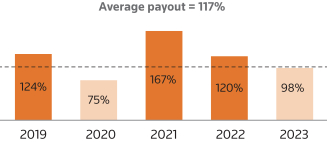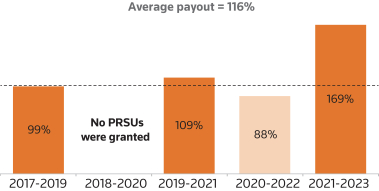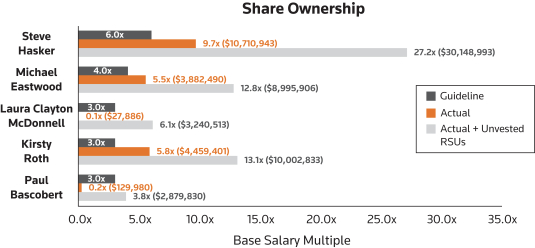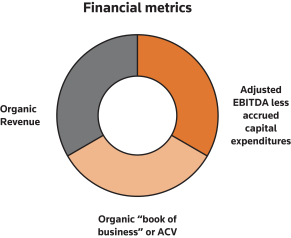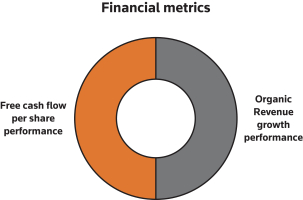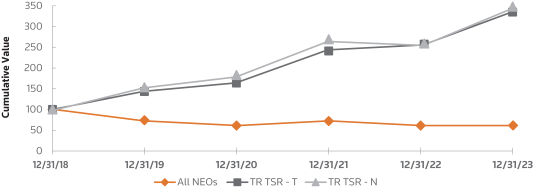are outstanding. This TDC is compared for each named executive officer against compensation peer group data, as discussed below, to both understand the competitive level of an individual’s pay as well to make decisions on each person’s future competitive compensation position.
Market data is one of several data points used by the HR Committee for setting compensation. While the HR Committee does not target a specific competitive level of pay, the HR Committee does consider the overall competitive market as well as the experience, skills, contribution, historical and expected performance of each executive in its decision making. The HR Committee also considers differences between the scope and criticality of the role at Thomson Reuters and at peers, internal equity and retention risk.
In March 2023, the HR Committee evaluated the current market position of our named executive officers’ compensation and approved an increase to Steve Hasker’s long-term incentive target and Mike Eastwood’s base salary and long-term incentive target to better align their pay with the market. There were no changes for the other named executive officers’ 2023 base salaries or their target annual and long-term incentive awards. FW Cook was consulted in connection with this compensation evaluation.
In June 2021, the HR Committee approved updates to the global and Canadian peer groups. As part of this process, the HR Committee’s independent compensation consultant reviewed the peer groups and identified changes that were intended to reflect Thomson Reuters’ evolving business strategy as it transitions from a content provider to a content-driven technology company.
The companies in our current global peer group are publicly traded and have similar business models or strategies which are focused on information development and electronic delivery. Our global peer group is a primary reference point considering the global nature of our business and the global market for executive talent. Although we believe our company is somewhat unique in terms of its business operations serving the legal, tax, accounting, corporate and news industries, a number of these companies are considered by analysts and shareholders to be our closest public company comparables. Many of these other companies, like Thomson Reuters, also have significant global operations.
When the global peer group was updated in June 2021, companies in that peer group had revenues in their last four quarters ranging from approximately $4.4 billion at the 25th percentile to approximately $9.6 billion at the 75th percentile, with a median of approximately $6.3 billion, compared to Thomson Reuters’ 2021 revenues of approximately $6.3 billion. Compared to the global peer group, Thomson Reuters ranked near the median in revenue, between the 25th percentile and median in adjusted EBITDA, in the top quartile in total assets, near the 75th percentile in market capitalization and between the median and 75th percentile in number of employees. The 15 companies in our current global peer group consist of:
| | | | |
Automatic Data Processing Inc. CGI Group Inc. eBay Inc. Equifax Inc. Experian Plc | | Gartner Inc. The Interpublic Group of Companies, Inc. Intuit Inc. Moody’s Corp. Omnicom Group Inc. | | RELX PLC S&P Global Inc. TransUnion Verisk Analytics, Inc. Wolters Kluwer NV |
For compensation benchmarking of the CEO, CFO and other executive officers based in Toronto, the HR Committee also utilizes a separate Canadian peer group as a secondary reference point. When the Canadian peer group was updated in June 2021, companies in that peer group had revenues in their last four quarters ranging from approximately $3.5 billion at the 25th percentile to approximately $18.2 billion at the 75th percentile, with a median of approximately $10.1 billion, compared to Thomson Reuters’ 2021 revenues of approximately $6.3 billion. Compared to the Canadian peer group, Thomson Reuters ranked between the 25th percentile and median in revenue, near the median in adjusted EBITDA, total assets and number of employees, and between the median and 75th percentile in market capitalization. The 17 companies in our Canadian peer group include Bank of Montreal, The Bank of Nova Scotia, BCE Inc., Canadian Imperial Bank of Commerce, CGI Group Inc., Cogeco Communications Inc., Constellation Software Inc., Intact Financial Corporation, National Bank of Canada, Open Text Corporation, Quebecor Inc., Rogers Communications Inc., Royal Bank of Canada, Shopify Inc., Stantec Inc., TELUS Communications Inc. and The Toronto-Dominion Bank.
The HR Committee also reviews compensation for executive officers based in the United States and Switzerland with data from their relevant local talent market.
Management Proxy Circular and Notice of Annual Meeting of Shareholders Page 69























